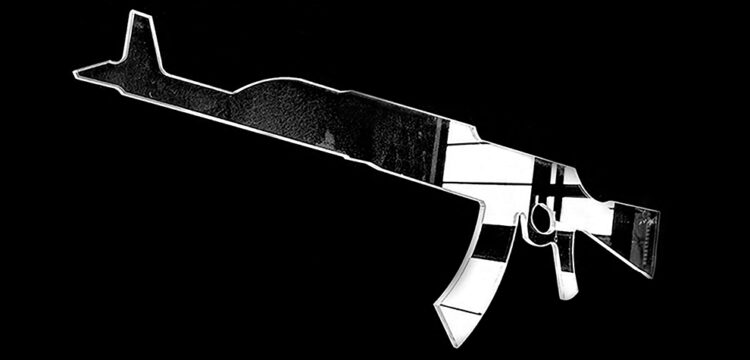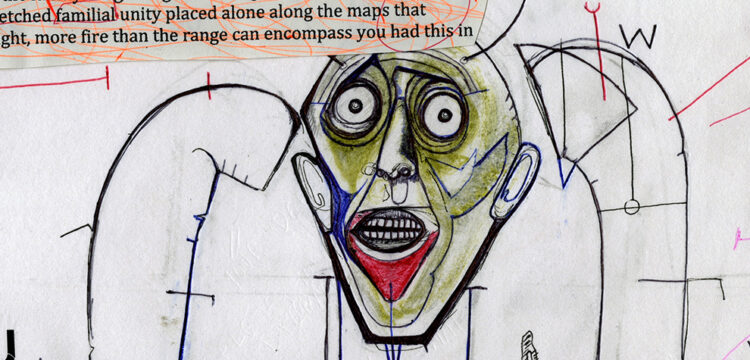The Book of Images
Mette Edvardsen in conversation with Silvia Fanti/Xing
On the occasion of the record launch of their new LP for XONG collection – artist records, Xing presents, the performance by Mette Edvardsen & Iben Edvardsen, Livre d’images sans images, on Friday 15 December 2023 at 10 pm, in its headquarters in Bologna, Raum.
Silvia Fanti: Let’s start with the title of your new creation, Livre d’images sans images. It appears extremely coherent with your path as an author and performer with a contemporary sensibility close to a conceptual approach that evokes presence through absences. And instead it was born from a nineteenth-century work by H.C. Andersen. How did you meet him/it and what motivated you to take it back and own it?
Mette Edvardsen: H.C. Andersen’s Livre d’images sans images from 1840 first came to us through another book, a Japanese manga series my daughter was very fond of, Le maître de livres by Shinohara Umiharu. We have read other stories by Andersen, but this one was unfamiliar to us both. As her reading language was French, we read it in French. Later I also thought that, as a title, it worked much better in French, as the English translation would be “Picture book without pictures”. The word “image” is important, it refers us to “imagination”, but also the idea of “image” opens something wider than a “picture” for our context. One thing is to evoke presence through absence, as “the book of images without images” suggests, and it’s true that this has been part of my artistic project for a long time. Another thing is that I think of dance and performance not as primarily a visual art form. Other senses are being engaged, such as listening, feeling, memory and imagination. I am interested in other forms of “image making”, so the book also resonated with this.
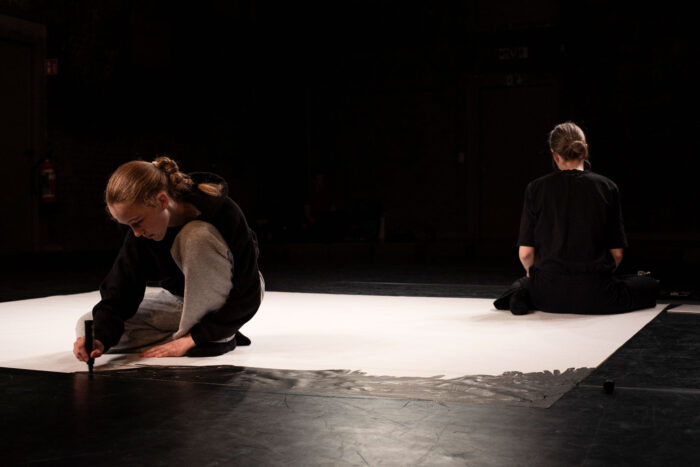
Livre d’images sans images is a project that consists of three different media: a live performance, vinyl and paper. How do these supports intertwine?
The idea of making a vinyl was there very early in the process. I was interested in the format of the record, the inscription of the tracks, the cracks. And to work with other sounds, as well as both live and recorded voice. We were making sound recordings and collecting some sound material as part of the material for the piece, like the recordings of the bats for example. So the vinyl was a very interesting surface to consider. A book with sound. The vinyl holds a sort of presence, it’s an interesting object. When we play the record during the performance, it’s not “just” sound. There are tracks on the vinyl we play ourselves during the piece, and other tracks that are only for the record. The LP comes together with some printed material, and the performance starts on a large empty sheet of paper.
What is the relationship between gesture and word in your production? For example I think of Black, a solo performance about making things appear. “The space is empty. There are no things. Through spoken words and movements in space a world becomes visible.” And between gesture and sound? You have also created an “opera in essay form”, Penelope Sleeps, together with the composer Matteo Fargion.
I think that gestures, words, voice, sound is all part of the material, the language I write with. In Black I used words and gestures to make things appear by naming them and relating them in space. Then I was speaking in repetition, to insist on the words beyond “just” understanding, as a way to make it physical, to make it last longer. This created a certain rhythm, a layer of sound. I say “I write in space and time.” It’s a way of saying that the material is composed, not from the point of view of writing a text from meaning, but that the form, the time, the rhythm is bringing the writing. So in continuation of this process, singing was a natural development. The singing voice resonates differently in space, carries words in another way, and makes us listen differently. In the piece oslo I worked with a choir that was seated amongst the audience, for a close listening. At times also creating harmonies, which opens other spaces, emotionally. For the opera Penelope Sleeps, we worked with a soprano singer, Angela Hicks, throughout the creation. Matteo was composing for her voice, and I wrote differently for the parts of texts that would be sung by her, and what I would speak in my own voice. The scale of the operatic voice could carry other words than the spoken or even naturally singing voice, so the writing was shaped by this.
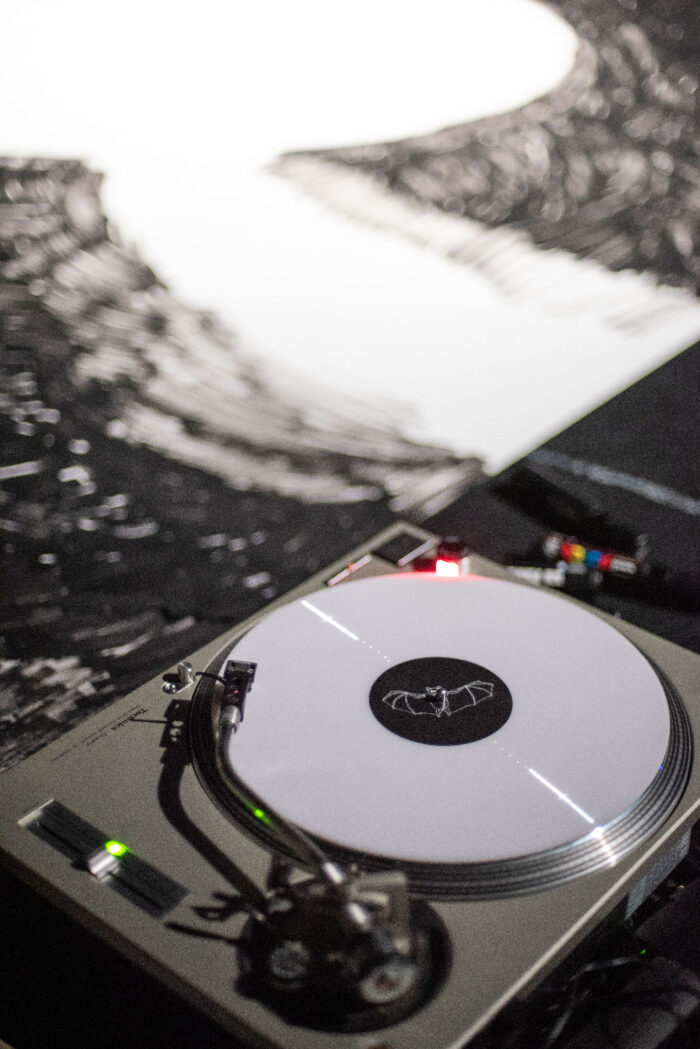
Livre d’images sans images is a performance, but also a record (coproduced by Xing and Varamo Press) that has an autonomous life. The challenge was to create the same identical object that could exist both on stage and off, presupposing a different use. The record is not a soundtrack. How do these two possibilities coexist?
This is for me what is interesting when making a work that operates with different media, different surfaces, or formats. It brings a lot to the thinking and working process, there’s a lot to figure out, but it is generative. I like to compose without creating unity. To let materials work upon each other, complement each other. In the book Livre d’images… the painter says that the Moon “did not show up every evening, sometimes a cloud came in between.” It’s a beautiful way of suggesting that things are not complete, we don’t get the whole picture. It’s knowing that fragments continue, elsewhere. And I think this supports this idea of questioning narratives, to consider that everything exists. We used this “weather report” as dramaturgy, as a compositional tool. By selecting some different things together, something is being created between them, not only in themselves.
You have an experimental approach to performativity. Your work with formats and the medium is always in question. Could we talk about expanded choreography?
I find it interesting to work with different formats as it makes me question or look at things differently each time. It makes me see something new, or from another perspective. In questioning the medium, I am also confirming it, or at least aspects of it. But it doesn’t mean I have to stick to it. I am not trying to do what it can do, or how it “should” be done, but rather to bring it into my context and then see. If I make a performance in a book, what does that mean? The point is not to illustrate that, but to see what it could be. When I started to work with language and writing, it’s not because I wanted to become a writer. I was interested in bringing language and writing into my practice of dance and choreography. Instead of defining it as something else, I was insisting on opening up the space within, to say “it can also be this”. I guess this is the notion of expanded choreography, which by the way has happened in many fields and disciplines. Today I am less concerned with what we call it or where we place it. My concern is more about how we hold the spaces for experimentation, to feel that things are at stake with art making, that art matters.
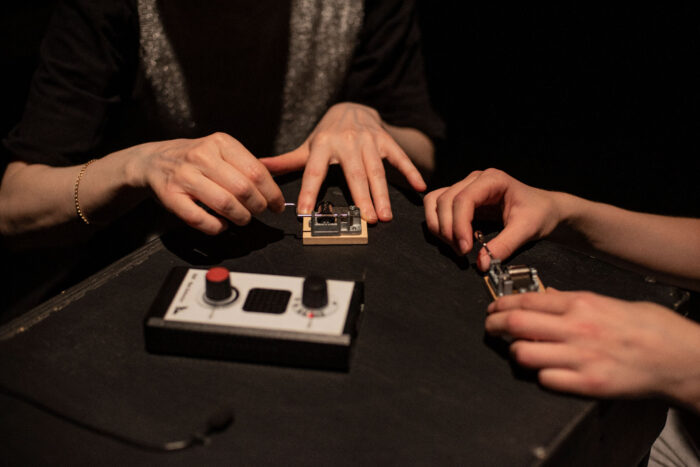
Space and time are the backbone of all your work. Could you say more? Somewhere you wrote: “trying to bridge the invincible gap between thought and experience, between here and there.”
This is a big question. I am always working with space and time, specifically. It’s of course always and inevitably an element when working with performance, but in my case it’s also part of what one could name as material in my pieces. I guess this “trying to bridge the gap” is what I am always busy with when making something. To get closer to, I don’t know, something that we don’t know, perhaps it’s a bit metaphysical. We know we never get there, we cannot bridge the gap, but we try. And this is what it’s about.
What about the structure of the record: One Side and Other Side? You also worked with field recording and acoustic presence?
On the one side, so the A side, we have tracks that we also play during the performance. It’s our voices, found material that we play with, field recordings we have made. We use a different order when we play live during the performance, than the order on the vinyl. This is because not everything that is in the performance is on the record. There was a selection. The vinyl also has another duration limit that we had to consider. And then for the B side, we were interested in the idea of the “other side”. You turn the record, and there is something on the other side. We decided to try to make something for the space of the record, for listening to the record at home. All the tracks on the vinyl are self-made. We are not experienced with sound. We create from another logic. On the other side there is one track, and it’s the recording of a room. We wanted to propose another room to be accompanied by, another presence. We tried to make some noises, but without creating a narrative or expectation that something would happen. So you could play the record at home, forget about it, then feel either spooked or comforted by the feeling of another presence, another room in your room.
Also there is the idea of the map, and the lists… I have the impression that you effectively used the record as a space to perform, which is the core concept of Xong collection: “The space of the record” is given focus and amplifies their poetics as both a sonic and physical phenomenon. Xong is a project that draws out divergent understandings of the performative and live arts, beyond genre and intersecting between different practices. Especially in your case there is altogether the white vinyl, the page, the stage..
The vinyl was important for the piece. It indeed created a space for us. It’s more than a sound recording, it’s an object which is also part of the performance, and is the performance. It’s like you say, both giving focus and amplifying. The overlapping spaces of the white vinyl, the page, and the stage (a large white sheet of paper)—it’s like we could enter all of these spaces and work there.
Tell us about Varamo press.
Varamo Press was created in 2018 together with dramaturg, writer, artist Jeroen Peeters in Brussels. In the context of a research on “choreography as writing”, at The National Academy of the Arts in Oslo, I decided to bring the texts, the words I speak, in the four pieces Black (2011), No Title (2014), We to be (2015) and oslo (2017) together on paper. Up until then I had been reluctant to share the texts on paper, to insist on the “writing in space and time”, to the body doing, over the written word. Then, as an experiment, I thought it could be interesting to bring all these writings together on the page, to see what would become visible, how would it read? Jeroen Peeters had in parallel written three essays, following the same timeline, where these pieces were the starting point for each essay. I asked him if he thought it would be interesting to bring his essays together. Could this be a double publication? Not knowing who would publish these two books, we started to fantasize about making a publishing house. And one thing led to the next. Now we are 14 books later, Livre d’image sans images (LP) being the latest edition. The catalogue consists of books by other choreographers, performance makers, artists. It’s an important activity for both Jeroen and me, in extension of our own artistic practices and work, a poetic space of its own.
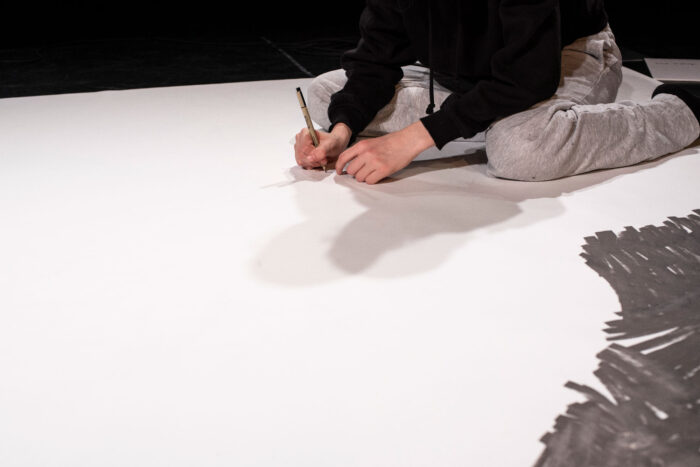
You present Livre d’images sans images as a project in collaboration with Iben Edvardsen, who happens to also be your 14 years old daughter. I appreciate this idea of artistic collaboration, which is not patronizing and recalls conversation. How do you see collaboration as a practice?
Iben turned 14 right before the premiere of the piece, she was 11 years old when we started. This piece has been on the threshold of so many things, postponed a couple of times due to the pandemic and other external events. And through this it has also become a time marker for us. We have of course not been working on it all the time, but I think this layer of time exists in the piece. Time spent with a certain material, time passing. Collaboration can take so many forms, but it is about doing something together. To me it’s precious. It’s also part of sharing a world, making connections and imaginations from what exists between us.
I realize with surprise that I didn’t mention the body yet in my questions. Your work is conceptual, but at the very end the performer is present through the body. And what we can see/listen is performing actions (never acting) where the body is a sign (not just a tool). Could this be a distillate of your style?
I would agree that we are performing, not acting. The body is doing, and is present through the voice as well. The first track of the vinyl is Iben’s voice reading from H.C. Andersen’s book Livre d’images sans images, a track we also play in the performance. She tells the beginning of the book, which is a conversation between a painter and the Moon. The Moon says she will visit the painter every evening and tell him about what she has seen on her journey around the world, and if he then paints what she describes to him, he will make a beautiful picture book. We really loved this idea of the conversation between the painter and the Moon, the idea of transmission and imagination, of inspiration and creation. We were thinking about how we were sharing ideas, references, materials—and of course, the main subject, how this “conversation” is happening between us (the piece) and the audience. There is a co-presence of other bodies there in the room with us.
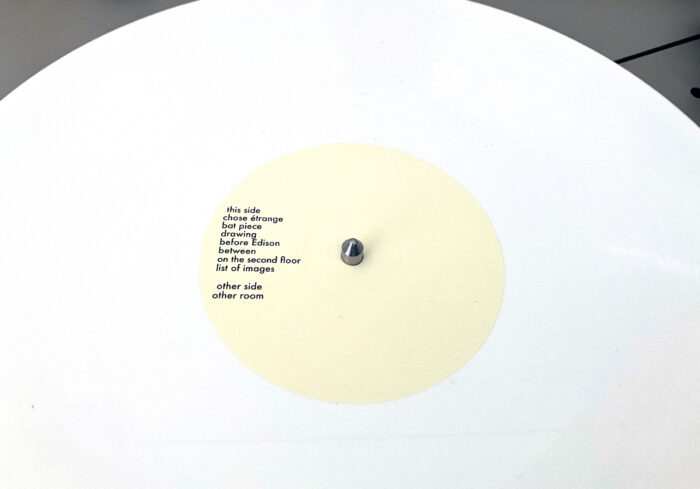
The collector’s edition of your record is accompanied by a poster, hand drawn with black marker by you two, and folded like a map. This echoes the activity of the performance. Can you tell more about drawing?
The performance begins with the two of us sitting on a large white sheet of paper, the audience seated in a circle around. One reference to this is the illustration of “the map of the ocean” from Lewis Carroll’s The Hunting of the Snark, “the map of nothing”. Throughout the performance we are drawing with black markers, coloring in the space until only an empty white circle is left. The moon, the vinyl, the world, a spotlight, a hole, a hope…




